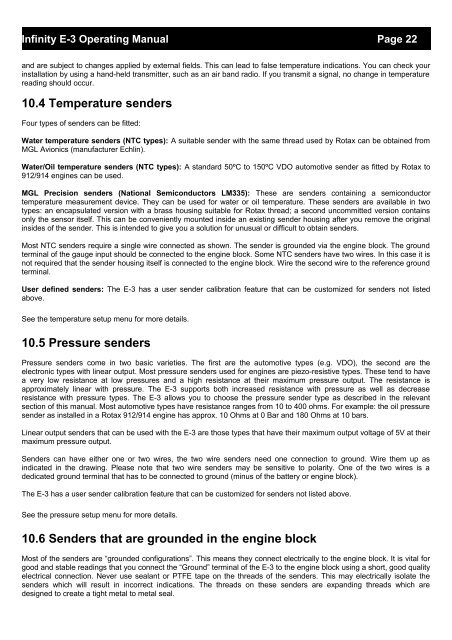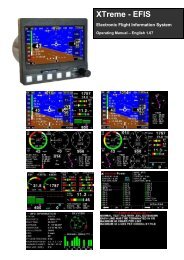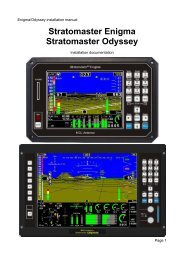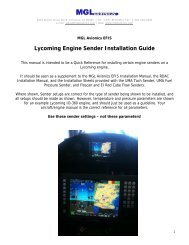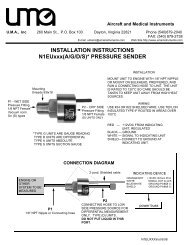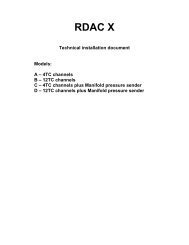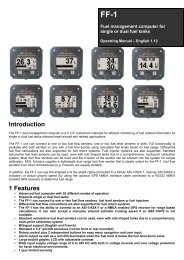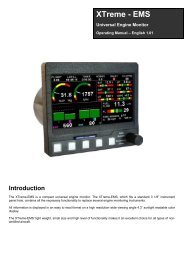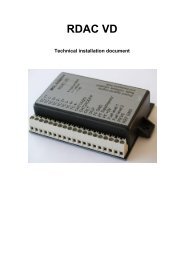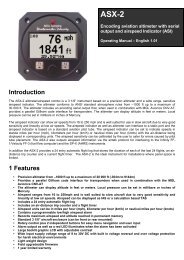Create successful ePaper yourself
Turn your PDF publications into a flip-book with our unique Google optimized e-Paper software.
Infinity E-3 Operating <strong>Manual</strong> Page 22and are subject to changes applied by external fields. This can lead to false temperature indications. You can check yourinstallation by using a hand-held transmitter, such as an air band radio. If you transmit a signal, no change in temperaturereading should occur.10.4 Temperature sendersFour types of senders can be fitted:Water temperature senders (NTC types): A suitable sender with the same thread used by Rotax can be obtained from<strong>MGL</strong> <strong>Avionics</strong> (manufacturer Echlin).Water/Oil temperature senders (NTC types): A standard 50ºC to 150ºC VDO automotive sender as fitted by Rotax to912/914 engines can be used.<strong>MGL</strong> Precision senders (National Semiconductors LM335): These are senders containing a semiconductortemperature measurement device. They can be used for water or oil temperature. These senders are available in twotypes: an encapsulated version with a brass housing suitable for Rotax thread; a second uncommitted version containsonly the sensor itself. This can be conveniently mounted inside an existing sender housing after you remove the originalinsides of the sender. This is intended to give you a solution for unusual or difficult to obtain senders.Most NTC senders require a single wire connected as shown. The sender is grounded via the engine block. The groundterminal of the gauge input should be connected to the engine block. Some NTC senders have two wires. In this case it isnot required that the sender housing itself is connected to the engine block. Wire the second wire to the reference groundterminal.User defined senders: The E-3 has a user sender calibration feature that can be customized for senders not listedabove.See the temperature setup menu for more details.10.5 Pressure sendersPressure senders come in two basic varieties. The first are the automotive types (e.g. VDO), the second are theelectronic types with linear output. Most pressure senders used for engines are piezo-resistive types. These tend to havea very low resistance at low pressures and a high resistance at their maximum pressure output. The resistance isapproximately linear with pressure. The E-3 supports both increased resistance with pressure as well as decreaseresistance with pressure types. The E-3 allows you to choose the pressure sender type as described in the relevantsection of this manual. Most automotive types have resistance ranges from 10 to 400 ohms. For example: the oil pressuresender as installed in a Rotax 912/914 engine has approx. 10 Ohms at 0 Bar and 180 Ohms at 10 bars.Linear output senders that can be used with the E-3 are those types that have their maximum output voltage of 5V at theirmaximum pressure output.Senders can have either one or two wires, the two wire senders need one connection to ground. Wire them up asindicated in the drawing. Please note that two wire senders may be sensitive to polarity. One of the two wires is adedicated ground terminal that has to be connected to ground (minus of the battery or engine block).The E-3 has a user sender calibration feature that can be customized for senders not listed above.See the pressure setup menu for more details.10.6 Senders that are grounded in the engine blockMost of the senders are “grounded configurations”. This means they connect electrically to the engine block. It is vital forgood and stable readings that you connect the “Ground” terminal of the E-3 to the engine block using a short, good qualityelectrical connection. Never use sealant or PTFE tape on the threads of the senders. This may electrically isolate thesenders which will result in incorrect indications. The threads on these senders are expanding threads which aredesigned to create a tight metal to metal seal.


